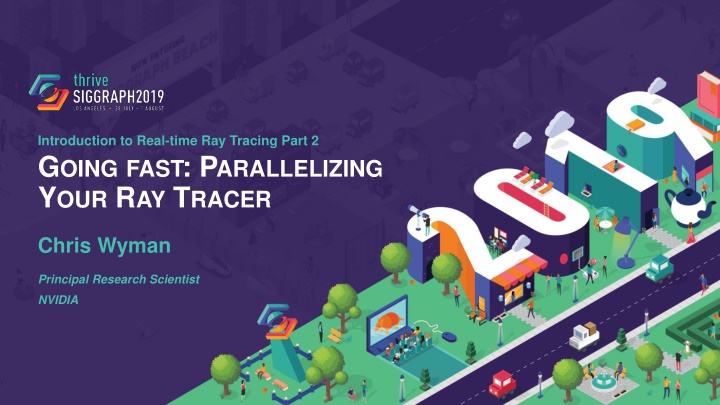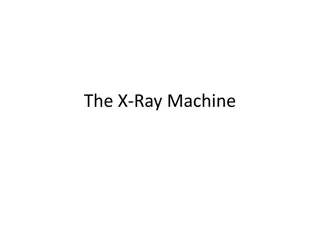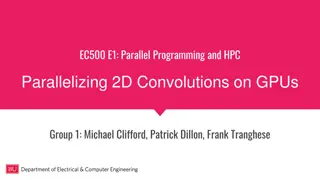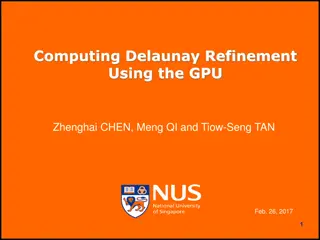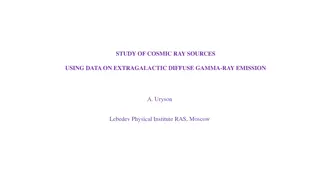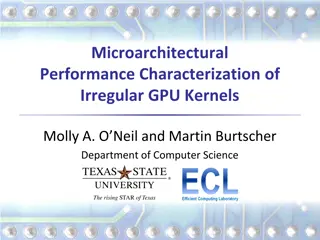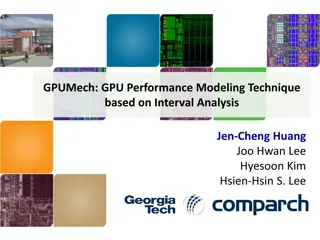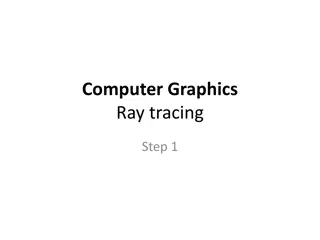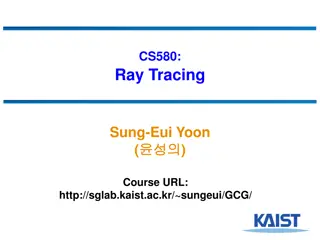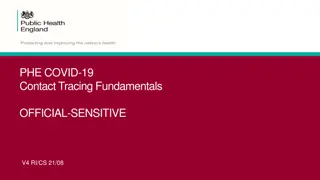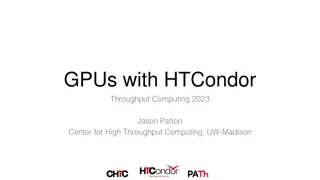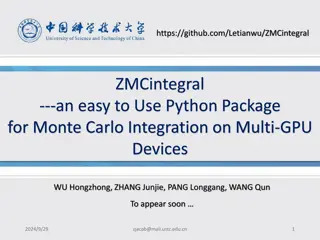Efficient Parallelization Techniques for GPU Ray Tracing
Dive into the world of real-time ray tracing with part 2 of this series, focusing on parallelizing your ray tracer for optimal performance. Explore the essentials needed before GPU ray tracing, handle materials, textures, and mesh files efficiently, and understand the complexities of rendering triangle meshes with additional features expected in GPU rendering.
Uploaded on Oct 03, 2024 | 3 Views
Download Presentation

Please find below an Image/Link to download the presentation.
The content on the website is provided AS IS for your information and personal use only. It may not be sold, licensed, or shared on other websites without obtaining consent from the author.If you encounter any issues during the download, it is possible that the publisher has removed the file from their server.
You are allowed to download the files provided on this website for personal or commercial use, subject to the condition that they are used lawfully. All files are the property of their respective owners.
The content on the website is provided AS IS for your information and personal use only. It may not be sold, licensed, or shared on other websites without obtaining consent from the author.
E N D
Presentation Transcript
Introduction to Real-time Ray Tracing Part 2 GOING FAST: PARALLELIZING YOUR RAY TRACER Chris Wyman Principal Research Scientist NVIDIA 1
SOME PRELIMINARIES Ideas needed before GPU ray tracing
YOU JUST GOT THE BASICS But additional features expected for GPU rendering 4
YOU JUST GOT THE BASICS But additional features expected for GPU rendering Typically, increased complexity; not just a few primitives 5
YOU JUST GOT THE BASICS But additional features expected for GPU rendering Typically, increased complexity; not just a few primitives Render triangle meshes Just collections of triangles approximating 3D shapes Easy enough; intersect each triangle in turn 6
YOU JUST GOT THE BASICS But additional features expected for GPU rendering Typically, increased complexity; not just a few primitives Render triangle meshes Just collections of triangles approximating 3D shapes Easy enough; intersect each triangle in turn Mesh files usually contain material information Often small-scale detail stored in textures 7
HOW TO HANDLE MATERIALS AND TEXTURES? Ray-primitive intersection Not just binary: Did we hit? Yes / No Also need to store attributes at the hit point, e.g.: Positions Normal Color 9
HOW TO HANDLE MATERIALS AND TEXTURES? Ray-primitive intersection Not just binary: Did we hit? Yes / No Also need to store attributes at the hit point, e.g.: Positions Normal Color Texture coordinates Material parameters Et cetera 10
HOW TO HANDLE MATERIALS AND TEXTURES? Ray-primitive intersection Not just binary: Did we hit? Yes / No Also need to store attributes at the hit point, e.g.: Positions Normal Color Texture coordinates Material parameters Et cetera Our texture: 11
HOW TO HANDLE MATERIALS AND TEXTURES? Ray-primitive intersection Not just binary: Did we hit? Yes / No Also need to store attributes at the hit point, e.g.: Positions Normal Color Texture coordinates Material parameters Et cetera Triangle vertices have: texture coordinates (0,0) (1,0) (0,1) 12
HOW TO HANDLE MATERIALS AND TEXTURES? Ray-primitive intersection Not just binary: Did we hit? Yes / No Also need to store attributes at the hit point, e.g.: Positions Normal Color Texture coordinates Material parameters Et cetera Triangle vertices have: texture coordinates (0,0) (1,0) Coordinate here: Interpolates coordinates at vertices (0,1) 13
HOW TO HANDLE MATERIALS AND TEXTURES? Ray-primitive intersection Not just binary: Did we hit? Yes / No Also need to store attributes at the hit point, e.g.: Positions Normal Color Texture coordinates Material parameters Et cetera Triangle vertices have: texture coordinates (0,0) (1,0) Coordinate here: Interpolates coordinates at vertices Same interpolation as position, normal, color, etc. (0,1) Use coord to index in the image array 14
HOW TO HANDLE MATERIALS AND TEXTURES? Ray-primitive intersection Not just binary: Did we hit? Yes / No Also need to store attributes at the hit point, e.g.: Positions Normal Color Texture coordinates Material parameters Et cetera All attribute interpolation work the same way 15
BASICS OF OPTIMIZATION Before jumping to GPU, take some baby steps
BEFORE DIVING INTO PARALLELIZATION Need to talk about some performance basics 17
BEFORE DIVING INTO PARALLELIZATION Need to talk about some performance basics Why is tracing rays slow at all? 18
BEFORE DIVING INTO PARALLELIZATION Need to talk about some performance basics Why is tracing rays slow at all? Consider basic ray tracing algorithm: Take a ray through your scene 19
BEFORE DIVING INTO PARALLELIZATION Need to talk about some performance basics Why is tracing rays slow at all? Consider basic ray tracing algorithm: Take a ray through your scene Test triangle to find intersection 20
BEFORE DIVING INTO PARALLELIZATION Need to talk about some performance basics Why is tracing rays slow at all? Consider basic ray tracing algorithm: Take a ray through your scene Test triangle to find intersection Repeat 21
BEFORE DIVING INTO PARALLELIZATION Need to talk about some performance basics Why is tracing rays slow at all? Consider basic ray tracing algorithm: Take a ray through your scene Test triangle to find intersection Repeat 22
BEFORE DIVING INTO PARALLELIZATION Need to talk about some performance basics Why is tracing rays slow at all? Consider basic ray tracing algorithm: Take a ray through your scene Test triangle to find intersection Repeat 23
BEFORE DIVING INTO PARALLELIZATION Need to talk about some performance basics Why is tracing rays slow at all? Consider basic ray tracing algorithm: Take a ray through your scene Test triangle to find intersection Repeat 24
BEFORE DIVING INTO PARALLELIZATION Need to talk about some performance basics Why is tracing rays slow at all? Consider basic ray tracing algorithm: Take a ray through your scene Test triangle to find intersection Repeat How do you know when you re done? 25
BEFORE DIVING INTO PARALLELIZATION Need to talk about some performance basics Why is tracing rays slow at all? Consider basic ray tracing algorithm: Take a ray through your scene Test triangle to find intersection Repeat How do you know when you re done? When you ve tested every triangle? 26
BEFORE DIVING INTO PARALLELIZATION Need to talk about some performance basics Why is tracing rays slow at all? Consider basic ray tracing algorithm: Take a ray through your scene Test triangle to find intersection Repeat How do you know when you re done? When you ve tested every triangle? Very expensive Every ray could test, 1 million (or more) triangles 27
WHATS OUR COMPUTATION BUDGET? Let s be easy on ourselves: Target just 1920 x 1080 at 60 fps 29
WHATS OUR COMPUTATION BUDGET? Let s be easy on ourselves: Target just 1920 x 1080 at 60 fps We need 125 million pixels per second! 30
WHATS OUR COMPUTATION BUDGET? Let s be easy on ourselves: Target just 1920 x 1080 at 60 fps We need 125 million pixels per second! With a ~10 TFLOP state-of-the-art GPU If tracing one ray per pixel About 80,000 flops per ray 31
WHATS OUR COMPUTATION BUDGET? Let s be easy on ourselves: Target just 1920 x 1080 at 60 fps We need 125 million pixels per second! With a ~10 TFLOP state-of-the-art GPU If tracing one ray per pixel About 80,000 flops per ray An optimized triangle intersection: ~10 flops Can afford at most 8,000 intersections per ray 32
WHATS OUR COMPUTATION BUDGET? Let s be easy on ourselves: Target just 1920 x 1080 at 60 fps We need 125 million pixels per second! With a ~10 TFLOP state-of-the-art GPU If tracing one ray per pixel About 80,000 flops per ray An optimized triangle intersection: ~10 flops Can afford at most 8,000 intersections per ray Conclusion: Don t test every triangle! 33
KEY PRINCIPAL TO OPTIMIZATION: Make the common case fast 34
KEY PRINCIPAL TO OPTIMIZATION: Make the common case fast Common case in ray tracing? Ray does not intersect a triangle 35
KEY PRINCIPAL TO OPTIMIZATION: Make the common case fast Common case in ray tracing? Ray does not intersect a triangle For any mesh, ray typically misses mesh 36
KEY PRINCIPAL TO OPTIMIZATION: Make the common case fast Common case in ray tracing? Ray does not intersect a triangle For any mesh, ray typically misses mesh Perhaps: First intersect a mesh bounding box 37
KEY PRINCIPAL TO OPTIMIZATION: Make the common case fast Common case in ray tracing? Ray does not intersect a triangle For any mesh, ray typically misses mesh Perhaps: First intersect a mesh bounding box Most rays avoid testing thousands of triangles But, extra box test when hit bunny 38
KEY PRINCIPAL TO OPTIMIZATION: What if you have thousands of bunnies? 39
KEY PRINCIPAL TO OPTIMIZATION: What if you have thousands of bunnies? 40
KEY PRINCIPAL TO OPTIMIZATION: What if you have thousands of bunnies? Common case: Ray misses most bunnies 41
KEY PRINCIPAL TO OPTIMIZATION: What if you have thousands of bunnies? Common case: Ray misses most bunnies Can skip testing this half 42
KEY PRINCIPAL TO OPTIMIZATION: What if you have thousands of bunnies? Common case: Ray misses most bunnies Can skip testing this half and this quarter with a few more boxes 43
KEY PRINCIPAL TO OPTIMIZATION: Build a tree of bounding boxes Known as a bounding volume hierarchy or BVH 44
KEY PRINCIPAL TO OPTIMIZATION: Build a tree of bounding boxes Known as a bounding volume hierarchy or BVH When using a principled tree build Reduces number of required intersections From O(N) to O(log N) 45
KEY PRINCIPAL TO OPTIMIZATION: Build a tree of bounding boxes Known as a bounding volume hierarchy or BVH When using a principled tree build Reduces number of required intersections From O(N) to O(log N) With a binary tree, 1 million ray-triangle tests becomes: Around 20 ray-box tests A few ray-triangle tests in leaf nodes 46
KEY PRINCIPAL TO OPTIMIZATION: Production ray tracers always use some acceleration structure 47
KEY PRINCIPAL TO OPTIMIZATION: Production ray tracers always use some acceleration structure But, which structure? How do you best build it? Literally decades of research 48
KEY PRINCIPAL TO OPTIMIZATION: Production ray tracers always use some acceleration structure But, which structure? How do you best build it? Literally decades of research Continuing to today (e.g., Wide BVH Traversal with a Short Stack, Vaidyanathan et al. 2019) 49
KEY PRINCIPAL TO OPTIMIZATION: Production ray tracers always use some acceleration structure But, which structure? How do you best build it? Literally decades of research Continuing to today (e.g., Wide BVH Traversal with a Short Stack, Vaidyanathan et al. 2019) When starting real-time ray tracing, best bet: Use someone else s code Quality of your BVH easily affects performance by 2x, 3x, or >10x Varies per scene! Luckily most APIs will build structure 50
